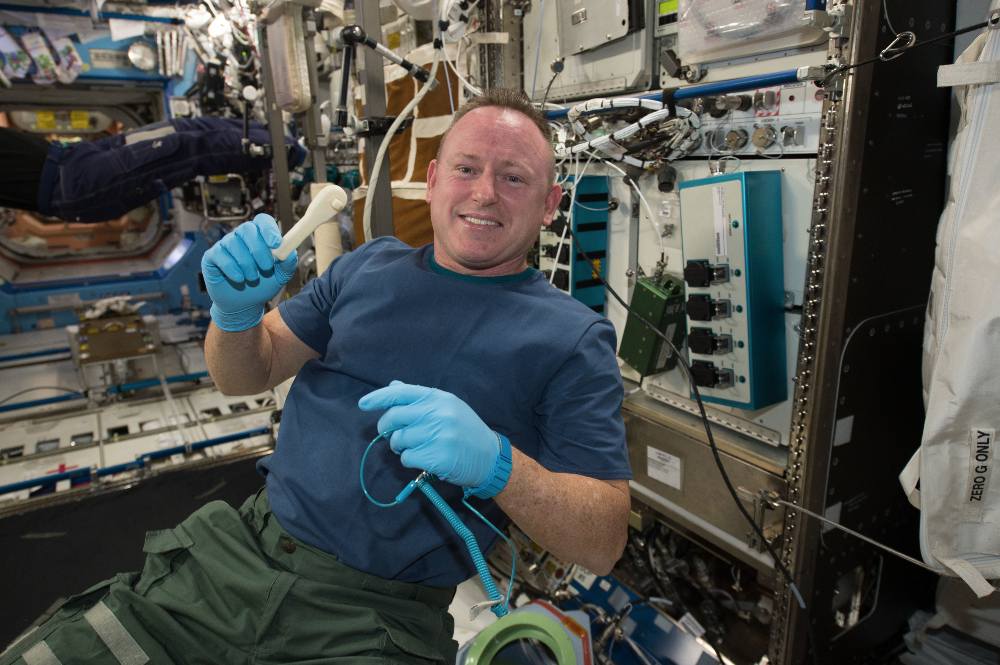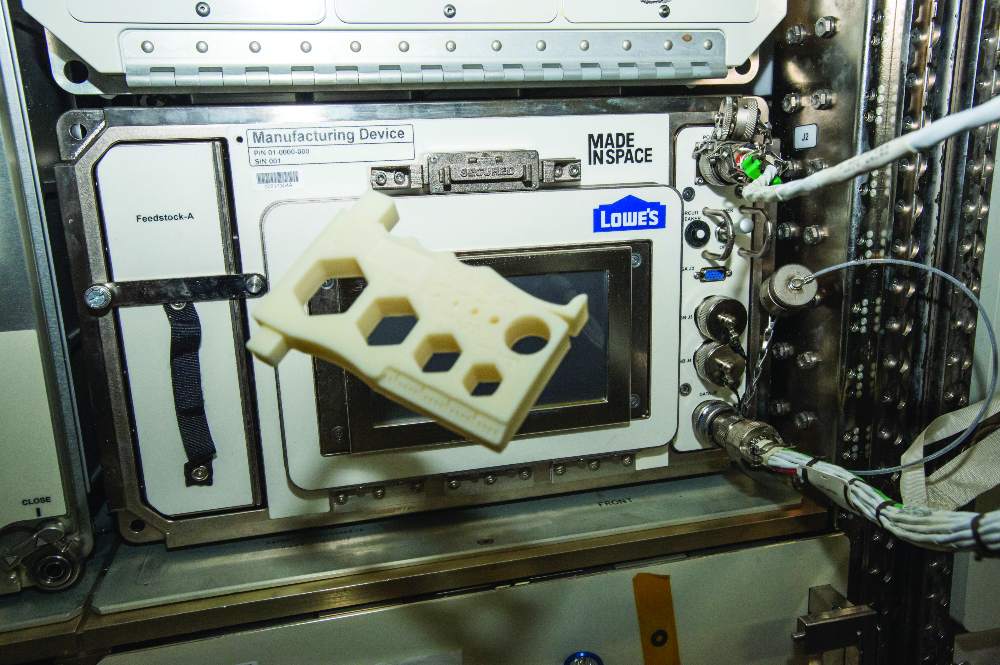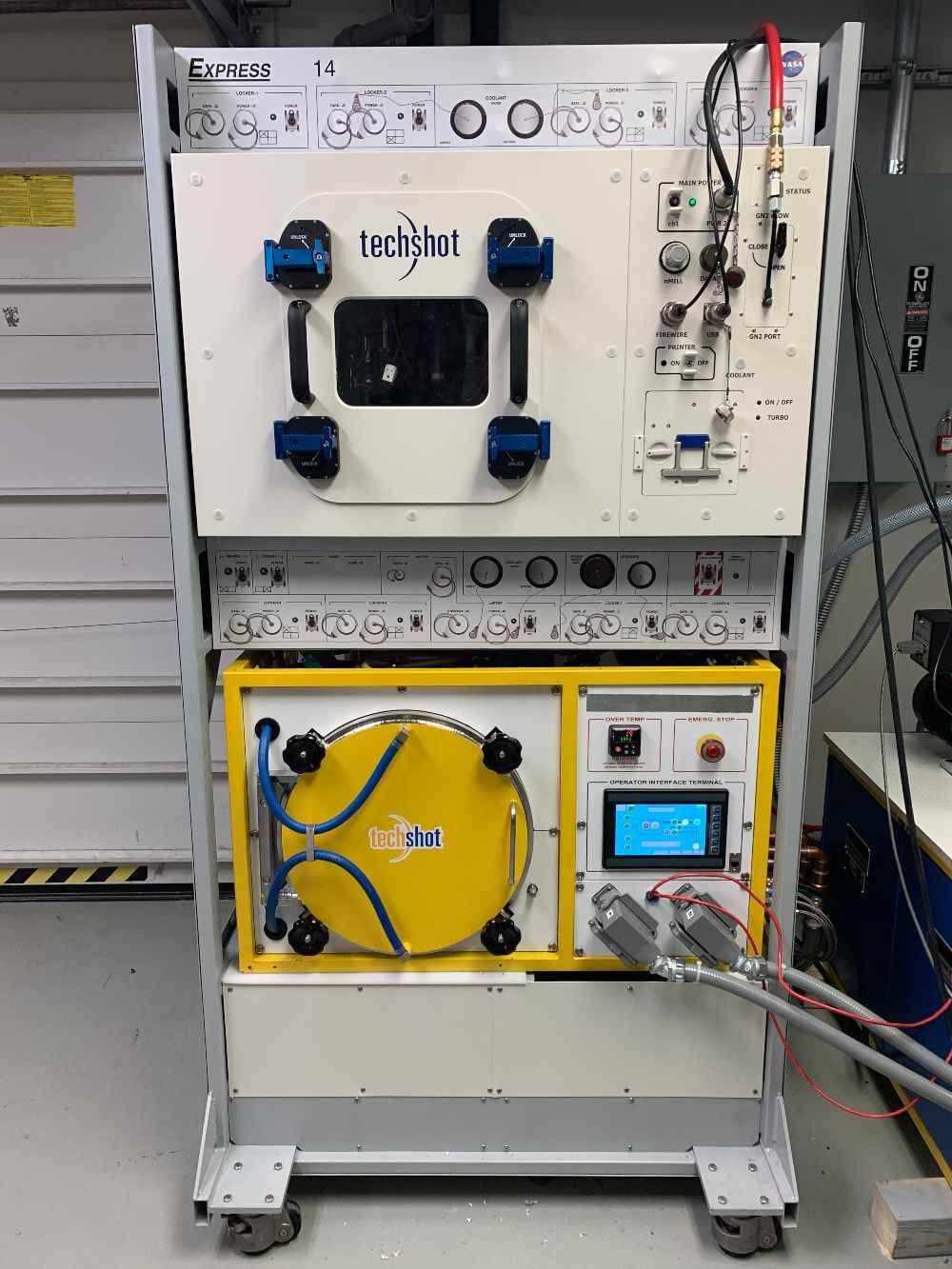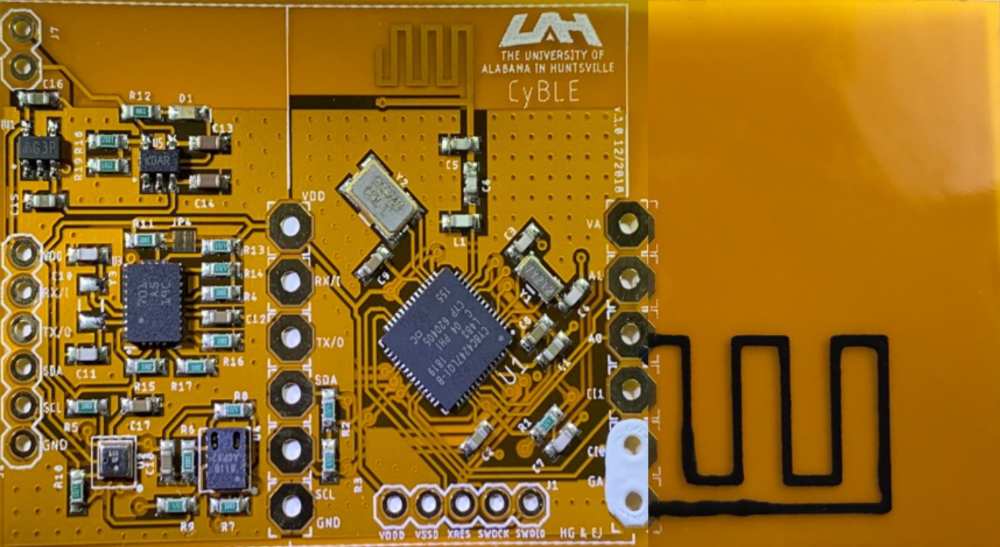When planning a mission to the International Space Station, NASA’s traditional approach has been similar to how one might prepare for a long camping trip: bring everything, ‘cause we’re not going home.
To support spaceflight missions, in fact, NASA sends up about 7,000 pounds of spare parts to the ISS every year, says Tracie Prater, a materials engineer at Marshall Space Flight Center.
“There are 29,000 pounds of hardware spares/replacement units on ISS and another 39,000 pounds on the ground ready to fly when needed,” Prater told Tech Briefs.
When you’re 200 miles from Earth, after all, you want to make sure that you have all of your necessary supplies, from bolts to cable mounts. NASA’s “better to be safe than sorry” approach, however, means that a vast majority of parts stored on ISS are never used.
While launch costs will decrease with a greater number of rocket manufacturers and an increased frequency of launches, sending a pound of cargo to low Earth orbit currently costs about $10,000, says Prater.
To lighten the load and reduce costs, NASA is using the ISS as a testbed to demonstrate a way of manufacturing the necessary parts in space: 3D printing.
To date, NASA’s additive manufacturing efforts for the International Space Station have focused mostly on the 3D printing of polymers, or plastics. The fused filament fabrication (FFF) process, the technique used by many desktop printers, works well in microgravity, is safe to operate in a crewed environment, and meets the International Space Station’s power, volume, and mass constraints.
Some plastics used on ISS are also recyclable – an important feature when considering efficiency and cost savings. One day the foam and films used to package cargo could potentially become the feedstock for manufacturing.
With the demonstration of successful 3D printing efforts on the International Space Station, NASA hopes to ultimately apply the additive manufacturing approach to long-duration missions like Mars exploration or sustained human operations on the lunar surface – scenarios where cargo resupply is not as readily available.
3D Printing on ISS (So Far)
NASA’s In-Space Manufacturing Project, begun at NASA Marshall, leads the development of technologies and processes that will enable on-demand manufacturing capability as teams explore the Moon, Mars, and other habitats far from Earth.
To date, in-space manufacturing demonstrations on ISS have included three initiatives:
- The 3D Printing in Zero G Technology Demonstration Mission
In collaboration with the Mountain View, CA-based startup Made in Space, through a Small Business Innovative Research (SBIR), NASA used a 3D printer for two rounds of operations from 2014-2016. The project investigated the effects of consistent microgravity on melt deposition additive manufacturing of a common polymer material.
The device is similar in size to a desktop 3D printer for plastics which you may have seen in homes, labs, or schools. Using a fused filament fabrication process, the system’s nozzle feeds a continuous thread of plastic through a heated extruder and onto a tray layer by layer to create a three-dimensional object. “It’s a little like a hot glue gun,” said Prater.
Analysis of specimens returned from orbit in conjunction with material modeling efforts suggested that microgravity did not lead to engineering-significant effects on the polymer parts, paving the way for increased use of this technology in space. One of its first printed parts: a wrench !

- The Additive Manufacturing Facility (AMF)
This commercial facility from Made in Space is a multi-material 3D printer for polymers. AMF manufactures with high density polyethylene (HDPE), ULTEM 9085 (a high strength blend of two other polymers), and ABS (acrylonitrile butadiene styrene, which is the most common plastic material for 3D printing and the focus of the original 3D printing in zero G experiment).
The Additive Manufacturing Facility has a 6 x 6 x 6-inch build envelope, and can therefore build a part measuring up to 6″ in length, width, and height. NASA has used AMF to investigate materials and produce functional parts on ISS, including an antenna part, an adaptor to hold a probe in an air outlet on the station’s oxygen generation system, and a part to connect two SPHERES , free-flying robots used for research on the space station.

- Recycling in Space
The ReFabricator unit, from the Seattle, WA-based aerospace company Tethers Unlimited, was flown to ISS in 2019. ReFabricator is designed to print parts with ULTEM 9085, which can then be recycled back into feedstock for further printing. A reuse capability enables NASA to “close the manufacturing loop” on long-duration missions so that the feedstock for the printers does not have to be launched. “We want mission planners to look at everything, even what would be ‘trash’ materials, as potential feedstock for manufacturing,” Prater told Tech Briefs.
In 2019, Made in Space also flew a polymer recycler , capable of processing plastic materials such as polyethylene into filament for 3D printing, to ISS. There are other manufacturing facilities on ISS that are not part of the in-space manufacturing project, although their results are followed closely. Several payloads, including the ZBLAN Fiber Facility from Made in Space, and a bioprinting facility from the Greenville, IN-headquartered company Techshot have flown through the ISS National Lab/CASIS.
NASA and Metal 3D Printing
Because many of the parts needed on space missions are aluminum, titanium, and steel, NASA is also working with a number of small businesses to develop metal printing capabilities for ISS.
On Earth, the preferred metal 3D printing method for aerospace is selective laser melting (SLM). In this process, metal powder is fed from a hopper onto a build plate. Each deposited layer is about the thickness of a human hair. A laser then selectively melts the powder and fuses it together. These systems, however, are very large and have high power requirements. Additionally, the powders are combustible, a respiration hazard, and would be difficult to manage/control in a microgravity environment.

Such constraints have driven NASA to consider other processes beyond SLM for adaptation to space: ultrasonic techniques that use force and vibrations to join adjacent layers of metal foil, wire+arc technologies that employ a welding process to deposit and fuse subsequent layers of metal wire, and bound metal deposition-type methods that use filament or pastes of metal particles packed in a polymer binder.
Current options being considered for metal manufacturing include ultrasonic additive manufacturing from companies like Columbus, OH-based Ultra Tech Machinery and Fabrisonic; wire+arc additive manufacturing from Made in Space; and a bound metal deposition-type process from Techshot. Still in the research phase, companies are developing ground-based prototypes of these systems.
A larger project called the Multimaterial Fabrication Laboratory (“FabLab” for short) from Techshot will include a metal additive manufacturing process, a furnace and endmill for post-processing of the printed part, and an in-process inspection capability which monitors the part as it is being built. The FabLab is designed to occupy a full EXPRESS rack on ISS.
NASA and Electronics Printing
Many of the components which malfunction or need to be replaced on ISS are electronic. Currently, NASA’s printed electronic team is fabricating sensors for various applications, such as CO2, humidity sensing, and crew health monitoring, which will be 3D-printed on the ground at first and then tested on ISS, perhaps in the next couple years, according to Prater.

A Q&A with Tracie Prater: 3D Printing and NASA
If NASA wants humans on the Moon by 2024 and boots on Mars by 2025, there is only so much that astronauts can pack for the camping trip. In the extended interview with Tracie Prater below, a materials engineer and the materials and processes laboratory lead for NASA’s In Space Manufacturing project at NASA Marshall, explains how a “just push print” approach could someday support long-duration missions.

Tech Briefs: What are the most common 3D-printed parts in space?
Tracie Prater: Because we were focused initially on evaluating the materials printed in space and comparing them with ground-manufactured materials, most of the samples printed to date were material test coupons. These are specimens we can pull apart, compress, or flex to derive characteristic material properties.
Since we are limited to polymers for printing currently, we mostly focus on production of parts which don’t have load bearing applications. In partnership with Made in Space, we printed a sensor cover for the radiation monitors in the BEAM module, a tow hitch which links two free-flying satellites known as SPHERES together in the ISS crewed environment, and a fixture to hold an airflow monitor, among others. These serve as examples of how 3D printing could be used to meet some mission needs as they occur in real-time.
Tech Briefs: How do you ensure that 3D-printed parts meet NASA requirements?
Tracie Prater: One major challenge going forward is verifying that parts printed in space meet requirements. Currently we are limited to visual inspection of the part (via cameras in the payloads or images collected by crew). We simply don’t have the skill sets or inspection capabilities on ISS that we do on Earth, like CT scanning, X-ray, and mechanical testing facilities).
What you ultimately want for in-space manufacturing is a part that is “born certified” – what that means is you are monitoring the build process and have a really good idea of what process signals (such as temperatures and surface roughness) correspond to an acceptable part. Advanced signal processing technologies and machine learning are under development to provide in-process monitoring and defect detection capabilities for additive manufacturing in ground systems. Someday we will have similar systems in our platforms for long-duration missions.
Tech Briefs: Are there options for post-process inspection?
Tracie Prater: There are also some options for post-process inspection that we are exploring. Tethers Unlimited and IERUS are developing a structured light scanning system as part of the Multimaterial Fabrication Laboratory activity. Structured light scanning stitches together images to create a three-dimensional rendering of a finished part and then compares it back to the part file/CAD model. With this technique, you can have an idea of where you are not meeting geometry or tolerancing requirements for the part.
Tech Briefs: How will 3D printing support long-duration missions?
Tracie Prater: We are taking a multi-pronged approach to maturing and adapting manufacturing technology so that it can be infused into long-duration missions beyond ISS. The first technology hurdle is demonstrating a metals manufacturing technique and extensively characterizing the materials produced with that technique in microgravity – that characterization work will give space systems designers an idea of the capabilities of the ISM system so that they can design (or redesign) their components for it to support on-demand production of spares on exploration missions.
It’s important to say that we are never asking designers to make their parts less reliable as reliability is always of utmost importance on a human long duration mission, but we do need to maintain consistent engagement with them to ensure that parts in habitat systems can be additively manufactured or redesigned for additive manufacturing if needed in a mission scenario.
Currently we are compiling a very large part database, in partnership with the small business Geocent,which consists of parts which could be manufactured on space missions. Eventually that digital database will interface with a metals manufacturing system, enabling an astronaut to “just push print” to manufacture a part. We also need a robust inspection or process monitoring capability and rigorous process control to ensure that system parameters are optimized and correspond to those which will produce best quality material.
Tech Briefs: How do you envision 3D printing advancing in the future?
Tracie Prater: Ultimately I envision a “one-stop shop” manufacturing system or even a suite of manufacturing capabilities that will be deployed on Gateway or in habitats on the lunar surface. The system will have an extensive library of parts which can be printed, an automated inspection capability, metals manufacturing, polymer manufacturing, and post-processing (like heat treatment and an endmill). The technologies in this system will be those we have successfully vetted on ISS. ISS is and will continue to be our testbed for exploration – it’s such a unique, incredible platform and the only place you can test systems in the extended microgravity environment with crew.
Tech Briefs: Why is 3D printing so important and valuable for space missions?
Tracie Prater: For me, 3D printing is about reducing logistics and the amount of mass you have to take. If we want to make spaceflight sustainable and lower the cost for long-duration missions, we can’t launch everything from Earth. We have to be able to use the materials we have around us.
The motto of our project is “Make it. Don’t take it.” I tend to think of human spaceflight as a long camping trip. If I’m close to home, I can easily get whatever I need when I need it, but if I’m far away (Mars is a 6-9-month one-way journey), I can’t pack everything I would ever need.
Perhaps the most exciting part of 3D printing for space missions is that you don’t necessarily know what you might need to print. Manufacturing enables you to create your own solutions. To me, this is a crew safety enhancement. After all, where would the Star Trek Enterprise be if Scotty couldn’t make anything?
What do you think? Share your comments and questions below.
Transcript
00:00:00 [ MUSIC ] The In-Space Refabricator - presented by Science@NASA While 3D printers are technology that many people are familiar with, there’s one 250 miles above us on the International Space Station (ISS) that’s unlike anything currently found on Earth. It’s known as the Refabricator, a hybrid 3D printer that can recycle its hard, polymer plastic numerous times to make new items. About the size of a dorm room refrigerator, the device is controlled by operators on Earth who oversee its manufacturing via video cameras. Niki Werkheiser, NASA’s In-Space Manufacturing Manager at Marshall Space Flight Center, in Huntsville, Alabama says: “Recyclers on Earth grind plastic pellets to create their products.
00:01:00 But that grinding creates material sheer which prevents you from reusing that plastic again, it’s no longer strong enough. For this technology demonstration, the company Tethers Unlimited developed a novel recycling process that doesn't require grinding, and that allows us to recycle the plastic multiple times.” The ability to reuse the plastic over and over again is essential for long-term space exploration. Werkheiser says: “We can replace a lot of the things we need when we’re orbiting above Earth; we just have them delivered on a resupply mission. But when you’re in deep space, you don’t have that option; you have to have the ability to make all of the parts you might need, and without having a large stockpile of extra materials.”
00:01:49 The Refabricator can even recycle plastic items not normally associated with Earthbound 3D printers. For instance, almost all of the materials that are delivered to the station are packed using foam or plastic bags. Both can be loaded into the Refabricator to deliver items such as a plastic syringe, an eating utensil, or a custom made wrench. That ability limits the amount of backup materials you need to take with you on a long range expedition. After all, in space, space is at a premium. The Refabricator’s technology demonstration will be composed of two phases. During each phase the Refabricator will perform seven cycles of recycling and printing parts while onboard the ISS. All of the items printed by the Refabricator will eventually be sent back to Earth for testing and analyses to determine the effects of repeated recycling on the material properties of the plastic.
00:02:50 Werkheiser notes, “I’m very excited about this technology both in space and back on Earth. I can envision a day where you go to your grocery store and drop your water bottles and plastic bags into a Refabricator, and then select your new phone case or a kitchen gadget or the raw filament that you can use in your 3D printer at home.” For more science from the International Space Station, go to www.nasa.gov/iss-science For more information about how the promise of future exploration is transforming today’s technology, visit science.nasa.gov


